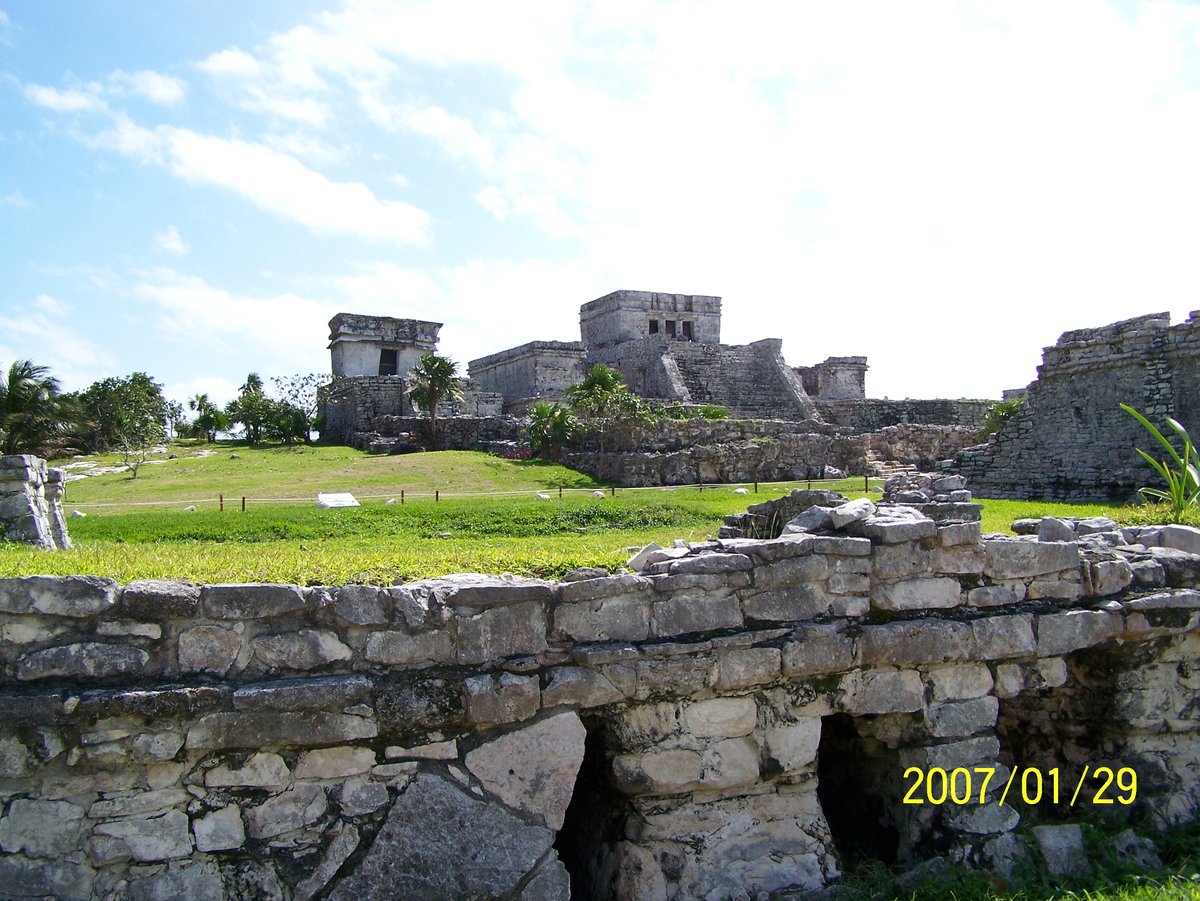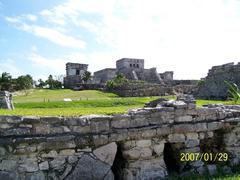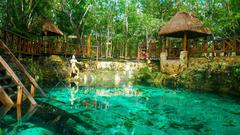
Maya Ruins of Tulum: Visiting Hours, Tickets, and Travel Guide
Date: 14/06/2025
Introduction: Why Visit the Maya Ruins of Tulum?
Perched atop dramatic limestone cliffs along Mexico’s Caribbean coast, the Maya ruins of Tulum are an awe-inspiring testament to ancient ingenuity, spiritual vision, and cultural resilience. Originally called Zamá, meaning “City of Dawn,” Tulum’s orientation toward the sunrise and its strategic role as a fortified port made it both a ceremonial and commercial epicenter in the late Postclassic Maya period (circa 1200–1521 CE). Its impressive defensive walls, stunning coastal setting, and meticulously aligned temples reflect a civilization deeply attuned to both earthly and cosmic rhythms (Insider’s Tulum; Tulum Times).
Visitors to Tulum can immerse themselves in rich history, marvel at iconic structures like El Castillo, the Temple of the Frescoes, and the Temple of the Descending God, and connect with the living cultural traditions of the Maya. The site’s proximity to pristine beaches, cenotes, and the Sian Ka’an Biosphere Reserve makes Tulum a unique destination where archaeology, nature, and spirituality converge (Delek Tulum; Nativa Tulum).
This detailed guide will explore Tulum’s history, architectural marvels, spiritual significance, and practical visitor information, ensuring a rewarding and responsible travel experience.
Contents
- The History and Cultural Significance of Tulum
- Visiting Tulum: Hours, Tickets, and Travel Tips
- Architectural Highlights
- Accessibility and Visitor Experience
- Nearby Attractions
- FAQs
- Visitor Recommendations
- Sources and Further Reading
The History and Cultural Significance of Tulum
Origins and Foundation
Founded in the 13th century CE as Zamá, Tulum became a crucial Maya port and ceremonial center. Its location atop cliffs offered both defense and spiritual symbolism, as the rising sun (east) was linked to renewal in Maya cosmology (Ancient Origins; Insider’s Tulum).
Defensive Architecture
Tulum’s name means “wall” in Yucatec Maya. The city is uniquely fortified with thick limestone walls on three sides and the Caribbean Sea on the fourth, stretching around 400 meters and reaching up to 5 meters in height (History Hit). These defenses protected the city from invaders and marked social boundaries within the settlement.
Trade and Economy
Tulum thrived as a major trading port, connecting maritime and overland routes across Mesoamerica. Goods such as jade, obsidian, turquoise, cacao, and textiles flowed through its harbor, fostering prosperity and cultural exchange (Insider’s Tulum; History Hit).
Spiritual and Political Life
Temples dedicated to deities like the Descending God and the Wind God, along with sacred cenotes, positioned Tulum as a spiritual hub (Delek Tulum). The city was governed by a Halach Uinic, the high priest and supreme leader, whose residence remains at the site (Insider’s Tulum).
Decline and Rediscovery
Tulum declined in the 16th century following Spanish conquest and disease, but local Maya continued rituals at the site for centuries. Rediscovered in the 20th century, it is now protected within Tulum National Park and the Sian Ka’an Biosphere Reserve (Delek Tulum).
Visiting Tulum: Hours, Tickets, and Travel Tips
Hours and Best Times to Visit
- Opening Hours: Daily from 8:00 AM to 5:00 PM (last entry by 4:30 PM).
- Best Time: Arrive at opening for cooler temperatures and fewer crowds, particularly between November and April (Viva La Travelista; Tulum Travel Secrets).
Tickets and Entry Fees
- General Admission: 80–100 MXN (~$4.50–6 USD); subject to change (Vacation in Tulum).
- Additional Fees: Professional cameras/GoPros may incur a 50 MXN fee.
- Payment: Cash only (Mexican pesos); bring small bills.
- Where to Buy: Purchase tickets only at the official entrance booth.
Getting There
- By Car: Drive south from Cancún or Playa del Carmen on Highway 307; well-marked turn-off to “Ruinas” (Viva La Travelista).
- Public Transport: Colectivos (shared vans) and taxis run from Tulum town and nearby cities.
- Tours: Many tours offer transportation and guided visits, often combined with cenotes or the Sian Ka’an Reserve (Every Steph).
Parking and Facilities
- Paid parking available near the entrance.
- A 15–20 minute walk or shuttle train takes you to the ticket booth.
- Restrooms, souvenir shops, and food stands are near the entrance; facilities inside the site are limited.
Accessibility
- Terrain is uneven with steps. Not fully wheelchair accessible; visitors with mobility challenges should plan accordingly.
What to Bring
- Comfortable walking shoes, sun hat, reef-safe sunscreen, water bottle, snacks, and a swimsuit if planning to swim at the beach.
Architectural Highlights
El Castillo
Dominating the site, El Castillo is a stepped pyramid atop the cliff, serving as a temple and navigational beacon for seafarers. Its alignment with the sunrise during solstices reflects Maya astronomical skill (tulumtimes.com).
Temple of the Frescoes
A two-story structure with vivid murals depicting gods and cosmology. The lower level served ceremonial purposes while the upper level functioned as an observatory (mexicocenotesandruins.com).
Temple of the Descending God
Recognizable by the upside-down deity above its doorway, this temple honors a figure symbolizing celestial descent and renewal, possibly linked to Venus (visit-mexico.mx).
Defensive Walls
Tulum’s thick limestone walls, with five gateways and two watchtowers, are among the best-preserved in the Maya world, enclosing the ceremonial core and elite residences.
Additional Structures
- Great Palace: Multi-chambered residence of the elite.
- House of the Cenote: Built beside a sacred sinkhole.
- Temple of the God of the Wind: Circular structure dedicated to Ehecatl, showing Central Mexican influence.
Construction and Symbolism
Buildings were constructed with local limestone, coated in stucco, and painted in vibrant hues. Many align with celestial events, underscoring the Maya’s advanced astronomical knowledge (tulumtimes.com).
Accessibility and Visitor Experience
- Duration: Plan for 1.5–3 hours at the site.
- Guided Tours: Highly recommended for deeper insight; available at the entrance and through pre-booked packages (The Custom Tour).
- Interpretation: Information panels are present, but guided tours offer richer context.
- Safety: Stay hydrated, wear sun protection, and remain on marked paths.
Nearby Attractions
- Tulum Beach: A small public beach beneath the cliffs is accessible for swimming after your visit (Voyage Mexique).
- Cenotes: Gran Cenote, Cenote Calavera, and Cenote Dos Ojos are popular for swimming and snorkeling.
- Sian Ka’an Biosphere Reserve: UNESCO-listed for its biodiversity and ecological value.
- Jaguar National Park: Includes protected beaches like Playa Paraíso and Playa Santa Fe.
Conservation and Responsibility
As Tulum welcomes over two million visitors each year, conservation is critical (Tulum Times). Help protect the site by:
- Respecting barriers and not climbing ruins.
- Using reef-safe sunscreen.
- Disposing of trash properly.
- Supporting local guides and artisans.
FAQs
What are the Tulum Ruins visiting hours?
8:00 AM to 5:00 PM daily, last entry by 4:30 PM.
How much do tickets cost?
80–100 MXN for general admission; additional camera fees may apply.
Can I swim at the Tulum Ruins?
Swimming is not allowed among the ruins, but the adjacent beach is open to the public.
Are guided tours available?
Yes, and they enrich your understanding of Maya history and culture.
Are the ruins wheelchair accessible?
The site has uneven terrain; accessibility is limited.
Visitor Recommendations
- Arrive early for cooler weather and fewer crowds.
- Bring cash in small denominations for admission and purchases.
- Wear comfortable, sun-protective clothing and sturdy shoes.
- Allow 2–3 hours for your visit, plus extra time for the beach or nearby cenotes.
- Book a guided tour for a deeper experience.
- Only purchase tickets at the official entrance to avoid scams.
For detailed planning, consult Vacation in Tulum’s visitor guide and Tulum Travel Secrets.
Summary
Tulum’s Maya ruins combine stunning coastal scenery with a rich tapestry of history, spirituality, and architectural achievement. As the “City of Dawn,” Tulum stands as a window into the Maya world—its rituals, trade, and cosmic wisdom. Protected within national parks and biosphere reserves, Tulum invites visitors to explore responsibly, honoring both ancient heritage and vibrant living traditions. Early arrival, official ticketing, guided tours, and sensitivity to conservation will ensure a memorable and meaningful visit (Ancient Origins; Tulum Travel Secrets; Nativa Tulum; Voyage Mexique).
For a seamless trip, download the Audiala app for personalized travel guides, ticket booking, and real-time updates.
Sources and Further Reading
- Insider’s Tulum
- Ancient Origins
- History Hit
- Delek Tulum
- Tulum Times
- Nativa Tulum
- Vacation in Tulum
- Viva La Travelista
- Tulum Travel Secrets
- Voyage Mexique
- Audiala app
Images and interactive maps throughout the article are optimized for SEO (“Tulum ruins panoramic view,” “El Castillo temple Tulum,” “Tulum archaeological site map”).


